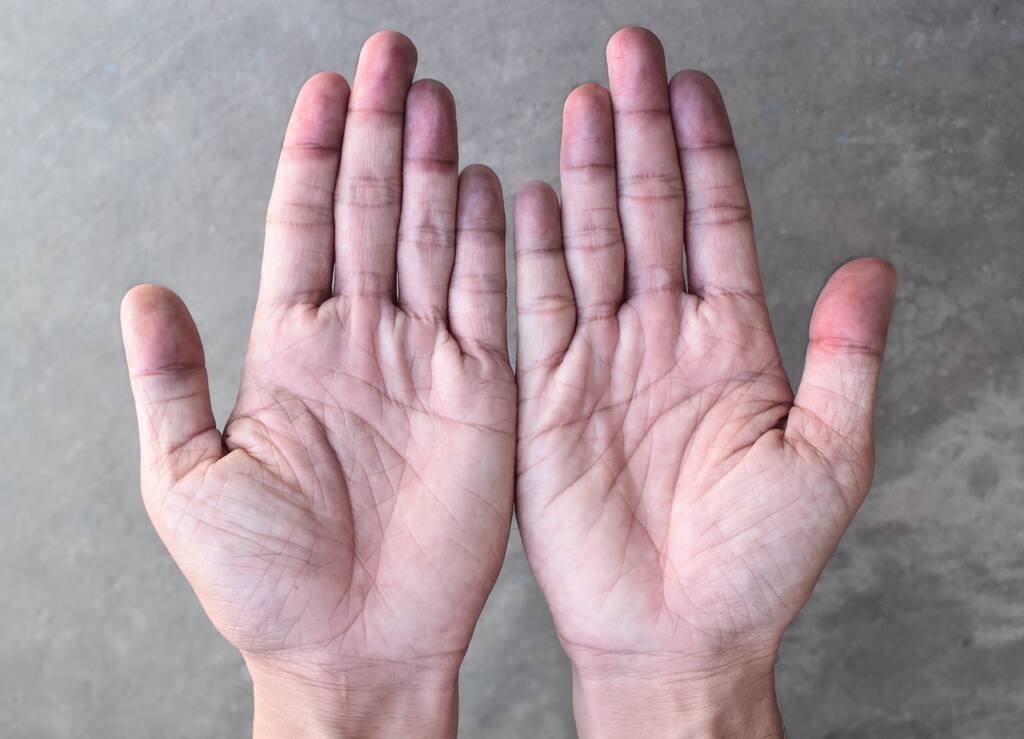Cyanosis occurs when your skin, lips, and/or nails have a bluish tint. It happens when your blood does not have enough oxygen to reach all of your body’s tissues. Cyanosis can result from a variety of situations. Some may have major medical issues. The reason determines the diagnosis and course of treatment. Typically, oxygen therapy is used as the first treatment. Cyanosis, a bluish, grayish, or purplish color on the skin, lips, or nails, can indicate a number of medical disorders, some of which are significant.
What is cyanosis?
Cyanosis is a medical term that describes when your skin, lips, or nails turn blue owing to a lack of oxygen in your bloodstream. If you have darker skin, cyanosis may be more visible in your lips, gums, nails, and eyes. The word cyanosis derives from the word cyan. Cyan is a bluish-green color. Normally, red blood cells transport oxygen to the tissues in your body. Your blood turns red when it’s full of oxygen because your blood cells are brilliant red. As a result, when oxygen-rich blood travels throughout your body, your skin appears pink or red. When your blood doesn’t have enough oxygen, it turns deeper and more blue or purple. The area of your body that is most affected by cyanosis might assist you pinpoint the cause.
Types of Cyanosis
The term “acrocyanosis” refers to cyanosis in the extremities, namely the palms and soles of the feet. It can also be found on the skin near the lips. Acrocyanosis in babies is usually normal as long as there is no cyanosis in the core section of the body. Children may experience acrocyanosis when they are chilly (for example, while swimming in cold water), but this should resolve soon they warm up.
“Central cyanosis” refers to cyanosis in the “central” regions of the body, such as the mouth, head, and torso. Central cyanosis is never normal in newborns and is almost always associated with low blood oxygen levels. It could be caused to an issue with the heart, lungs, or blood.
What are the symptoms of cyanosis?
The primary sign of cyanosis is bluish staining of the skin. The bluish tone could also damage your lips, tongue, gums, ears, and nails. If you have dark skin, cyanosis may seem gray or white. It may also appear more frequently on your lips, tongue, gums, nails, and eyes. Cyanosis is usually caused by another condition. Other signs of cyanosis may include:
- Hypothermia (low body temperature).
- Your arms and legs may feel numb or tingly.
- Coughing.
- Wheezing.
- Difficulty breathing.
- Dizziness.
- Extreme exhaustion (fatigue).
- Weakness.
How long does it take for cyanosis to develop?
In heart failure, lung embolism, pneumonia, or an acute severe asthma attack, cyanosis may occur suddenly or abruptly as the patient “begins to turn blue” due to a lack of oxygen. On the other hand, people with chronic obstructive pulmonary disease, or COPD, frequently acquire cyanosis over time.
What are the several types of cyanosis. Peripheral Cyanosis
Peripheral cyanosis occurs in the fingers and toes. It occurs when the body is unable to pump oxygen-rich blood to certain places, whether owing to a cold or another medical condition. Cyanosis is defined as a bluish, purple, or grayish hue on the skin and mucous membranes. Peripheral cyanosis, also known as acrocyanosis, affects mostly the hands and feet. Cold temperatures can restrict blood vessels, resulting in blue-tinged skin. Warming or rubbing the blue regions should restore blood flow and color to the skin.
Peripheral Cyanosis Causes
The vivid red color commonly associated with blood indicates that it is rich in oxygen. When blood contains less oxygen and becomes a darker red, more blue light is reflected, giving the skin a blue or gray color. Being chilly is the most prevalent cause of blue hands and feet. Even if your extremities are warm, you can still get blue hands and feet. Peripheral cyanosis may indicate a problem with your body’s system for supplying oxygen-rich blood to the tissues in your hands and feet. It could also be a result of low oxygen levels in red blood cells. Your blood is essential for transporting oxygen throughout your body, from your lungs to your heart. It is pumped via your arteries and into the rest of your body.
Central cyanosis
Central cyanosis is a generalized bluish staining of the body and visible mucous membranes caused by insufficient oxygenation as a result of situations that increase deoxygenated hemoglobin or the presence of aberrant hemoglobin.
Causes of Central Cyanosis
- Hypoventilation can occur as a result of central nervous system diseases such as cerebral hemorrhage, tonic-clonic seizures, or heroin overdose.
- Bronchospasm (asthma), pulmonary embolism, pneumonia, bronchiolitis, pulmonary hypertension, hypoventilation, and COPD are examples of pulmonary causes that result in ventilation-perfusion mismatch and poor alveolar-arterial diffusion.
- Heart failure, congenital heart illnesses (right-to-left shunting), and valvular heart disease are all cardiovascular causes.
- Hemoglobinopathies include methemoglobinemia and sulfhemoglobinemia.
- Polycythemia
- High altitude can lead to hypothermia.
- Obstructive Sleep Apnea
Circumoral Cyanosis
Cyanosis is a skin disorder characterized by a blue tinge. It happens in locations where the blood in surface blood vessels contains less oxygen. It could be an indication of a medical emergency. Circumoral cyanosis is defined as blue staining around the mouth only. It is commonly found in neonates, particularly above the upper lip. If your child has darker skin, the discolouration may appear more grey or white. You may also see it on their hands and feet. While the appearance of circumoral cyanosis can be concerning, there are a few things you can rapidly look for to rule out a medical issue.
Causes of Circumoral Cyanosis
Circumoral cyanosis is a kind of acrocyanosis. Acrocyanosis occurs when small blood vessels contract in reaction to cold. This is fairly common in infants within the first few days following birth. Circumoral cyanosis in older children frequently occurs when they walk outside in cold weather or get out of a warm bath. This sort of cyanosis should subside as they warm up. If it doesn’t, get immediate medical attention. Circumoral cyanosis that does not go away with heat may indicate a significant lung or heart condition, such as cyanotic congenital heart disease.
Diagnosis of Cyanosis
Cyanosis is diagnosed based on a history, physical examination, and diagnostic testing. The history will include the start of symptoms, duration, severity, and previous medical history. A physical examination is performed to identify regions affected by cyanosis. Examine your hands, feet, lips, eyes, and the inside of your mouth for bluish discoloration. CBC, pulse oximetry, arterial blood gases, ECG, echocardiography, and hemoglobin electrophoresis are among lab tests that can be used to determine a possible cause. Your doctor may also request X-rays or CT scans to assess the health of your heart and lungs.
Treatment for Cyanosis
Most cases of cyanosis in children are caused by “acrocyanosis” and do not require treatment. If the child has a primary lung or heart problem, the cyanosis will resolve if the underlying condition is treated, either medically or surgically. Cyanosis can be a sign of a variety of illnesses. The treatment for cyanosis will be determined by its cause. Oxygen therapy may be one of the first therapies recommended by your healthcare practitioner. Oxygen therapy gives you extra oxygen to help you increase your levels quickly. The severity of your ailment may necessitate the use of a breathing machine or ventilator.
Other possible therapies are
- Warmth and massage: Exposure to cold temperatures and conditions like Raynaud’s phenomenon can be addressed by warming and rubbing the afflicted areas.
- Antibiotics can help treat infections like pneumonia.
- Other drugs: Your physician may give medications to treat heart and lung problems.
- Discontinuing medication: Your healthcare practitioner may advise you to stop using certain medications.
- Inhalers: If your cyanosis was caused by a lung ailment such as asthma or COPD, your doctor may prescribe an inhaler to help your lungs function more effectively.
- Surgery: Congenital heart abnormalities such as tetralogy of Fallot may necessitate surgery shortly after birth.
Prevention
The prevention of cyanosis is linked to the prevention of factors that can lead to poor blood circulation or decreased oxygen saturation. Annual tests can help you understand your heart and respiratory symptoms, and any abnormalities may be detected earlier. If you have a history of a medical condition that could lead to cyanosis, speak with your doctor about how to lower your risk.
Conclusion
The term cyanosis refers to a bluish-purple skin tone. It is especially noticeable when the skin is thin, such as the lips, mouth, earlobes, and fingernails. Cyanosis suggests that there may be less oxygen bound to red blood cells in the bloodstream. It may indicate an issue with the lungs or the heart. Cyanosis is determined by observation rather than scientific testing. Circumoral cyanosis can be scary, particularly for new parents. However, it is usually not a major problem as long as the blue coloring is limited to the mouth and not the lips. Warming your infant up with hugging or a blanket should cause the blue tint to recede. If it doesn’t, and your child is having difficulties eating or breathing, transport them to the emergency department as soon as possible. Peripheral cyanosis is most commonly caused by cold temperatures. Once your body has warmed up, your discolored hands or feet should return to their original hue. However, an underlying issue could be producing the coloring. If this appears to be the case, or if you have other noticeable symptoms, such as difficulty breathing, seek medical assistance right once.
FAQs
Can cyanosis cause anemia?
Cyanosis is caused by an increase in deoxygenated hemoglobin levels exceeding 5 g/dl. In fact, people with anemia do not exhibit cyanosis until their oxygen saturation (also known as SaO2) drops below normal hemoglobin values.
How do you prevent cyanosis?
There are many different reasons for cyanosis and they can’t all be prevented. But there are some things you can do to prevent the condition. Your healthcare provider may recommend you stop taking any medications that restrict your blood flow. You should also quit smoking and limit your caffeine intake.
Does cyanosis induce pain?
Some reasons can be life-threatening. If a person develops cyanosis and any of the following symptoms, they require emergency medical attention: Having trouble breathing, such as gasping for air. Chest discomfort.
At what level of HB does cyanosis occur?
Central cyanosis develops when the level of deoxygenated hemoglobin in the arteries exceeds 5 g/dL and oxygen saturation falls below 85%. The bluish color can be noticed all over the body, including the exposed mucosa.
Which component exhibits cyanosis?
The term cyanosis refers to a bluish-purple skin tone. It is especially noticeable when the skin is thin, such as the lips, mouth, earlobes, and fingernails. Cyanosis suggests that there may be less oxygen bound to red blood cells in the bloodstream.
What color does cyanosis turn to?
People with low blood oxygen levels have bluish skin. This condition is referred to as cyanosis. Depending on the reason, cyanosis might occur rapidly, accompanied with shortness of breath and other symptoms. Cyanosis caused by long-term cardiac or lung difficulties might progress slowly.


